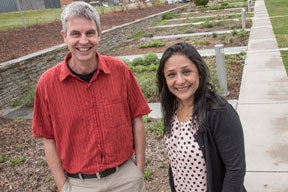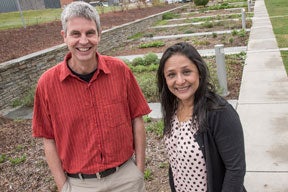 KINGSTON, R.I. – April 26, 2016 – Water crises are percolating all around the United States, from droughts in the Southwest to lead in the drinking water in Flint, Mich. And yet very little is known about how water is used in the United States, who uses it and how much is used. This lack of data makes it difficult to make proper water use decisions and to improve water conservation efforts.
KINGSTON, R.I. – April 26, 2016 – Water crises are percolating all around the United States, from droughts in the Southwest to lead in the drinking water in Flint, Mich. And yet very little is known about how water is used in the United States, who uses it and how much is used. This lack of data makes it difficult to make proper water use decisions and to improve water conservation efforts.
But thanks to two University of Rhode Island researchers, data about water use in Rhode Island may soon become more readily available. And they hope it will open the floodgates of data collection for the rest of the region and country.
According to Soni Pradhanang, assistant professor of geosciences at URI, the U.S. Geological Survey (USGS) collects data about water use only every 5 years. In Rhode Island, that data is provided by the Rhode Island Water Resources Board, which gathers information about drinking water, surface water, well water and other water sources from a wide variety of water utilities and users.
“But the Water Resources Board receives that data in so many different formats that it struggles to put that data into a single format to give to USGS,” said Pradhanang, who is collaborating with URI Professor Thomas Boving on the project. “It’s hard to change the behavior of so many different water use agencies that are used to using their own data template.”
So Pradhanang and Boving have been contracted by the Water Resources Board to identify a versatile database management tool that can easily combine data provided in various formats so it can be analyzed, stored and displayed in many forms for any Rhode Islander to access.
The two URI hydrologists led a workshop last month for representatives of USGS, the Water Resources Board, the Rhode Department of Health, Rhode Island Department of Administration and others to outline the problem and discuss how best to address it.
“It’s all about conserving and managing water resources in the proper way,” said Pradhanang. “If you know what group is using how much water, it will help to apportion the available water. But to do that, we have to have up-to-date water use information.”
The issue isn’t going to go away.
“Climate change is likely to make wet areas wetter and dry areas drier,” Pradhanang said. “Precipitation events will get extreme. Early snow melt and the shift in the timing of snow is a big deal in the Northeast and affects the filling of reservoirs and what happens downstream. These are big issues for water regulators.”
Rhode Islanders used 108 million gallons of water per day in 2010, based on the most recent USGS report.
Pradhanang said that the timing of precipitation has significant implications for water use and water availability. Intense rainstorms in March 2010 and October 2005, for example, brought the same amount of rain but had far different outcomes.
“The impact was much bigger in 2010, including serious flooding, because it happened in March when the reservoirs were already full,” she said. “The 2005 storm had little impact because it followed our usual dry summer.”
Pradhanang and Boving will make a recommendation to the Water Resources Board by June 1 about the optimal database management system, and they hope the new system will be operational sometime in 2017, depending on funding.
“Water use management and conservation are all about information,” said Pradhanang. “Collecting good information will lead to better reporting and better decision making.”
Pictured above
URI geosciences professors Thomas Boving and Soni Pradhanang.
URI photo by Michael Salerno Photography

